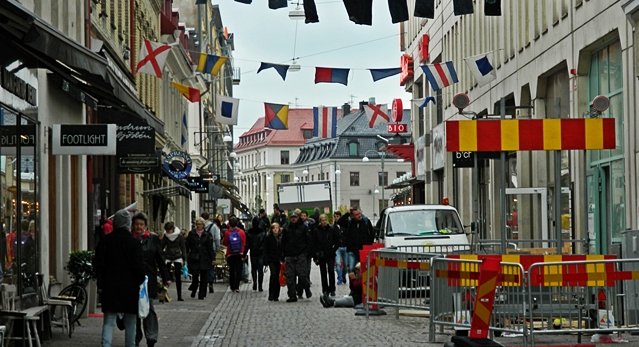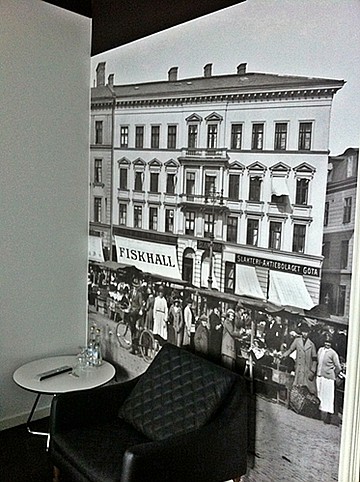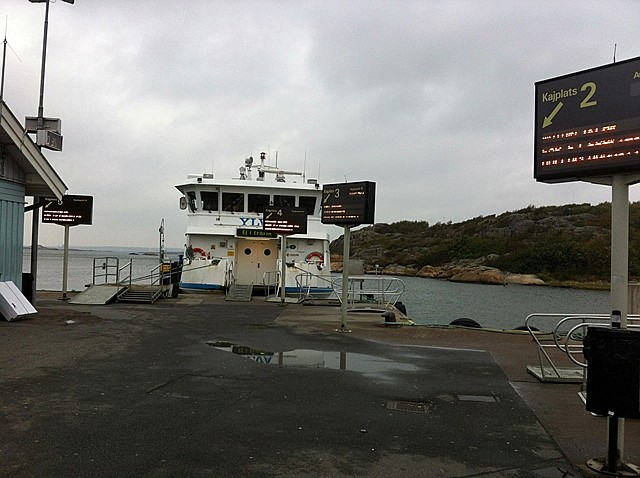 Facebook
Facebook
 X
X
 Instagram
Instagram
 TikTok
TikTok
 Youtube
Youtube

Gothenburg, Sweden, is the country’s second-largest city, and yet it’s not on most Americans' radar. It should be! It’s an important commercial port, Volvo’s headquarters, a college town, a gourmet food destination and a fashion mecca.
Where to stay. The Hotel Flora is a funky little boutique hotel where you’ll see younger couples and in-the-know European businessmen checking in. The location is centrally located: many of their trams (light rail trains) stop within a block, and there are shopping districts within walking distance.
Even in my haze of jet lag and not being able to figure out Swedish street signs, I found the place; it’s right on a canal.

The rooms are petite but super-cool in their interior design. The building was an Edwardian-era fish market. Life-sized vintage photos of the area were made into the wallpaper (left). Acrylic was cut out like a paper snowflake to make the light fixture. White goose-down pillows and comforters are toasty on a cold, Swedish night. Bring an electrical adapter that’s round with two prongs and fits into recessed round outlets.
The breakfast buffet is a bar in the later part of the day and they keep the lights low there, even come morning. It’s a comforting touch, whether your eyes feel like they’re still in another time zone or you’ve imbibed too much Swedish vodka the night before.
Gothenburg has an archipelago in the west where people really do live and work – so much so that their public transportation includes an hourly boat that stops off at the different islands.
Pensionat Styrsö Skäret is on the island of Styrsö. Tell the boat captain that you have to go to Styrsö Skäret; it’s not one of their regular stops. When you’re ready to come home, adjust the mirrored signal at the dock so the boat can see you need to be picked up.

There are no cars on the islands; people get around on foot or on scooters. I understand that each island has its own personality: some are where fishermen live, some are “very religious,” some have high-end boutiques and some are for artists.
Styrsö Skäret is owned by Ola Tulldahl and his wife Ylva, a young couple who have been in the hospitality business for several years. Despite their youthful age, they’re renovating the grand cottage on the hill to resemble "grandmother's house." It has an eclectic, vintage style, rather than the ubiquitous modern Scandanavian look. Don't worry, you won't be knocked in the face by Hummel figurines – instead, you'll be comforted by touches like a real burning fireplace and sink-in sofas.
People visiting love to walk or borrow a bike to check out the island's rugged, beautiful scenery. Ola can also arrange for one of the area’s famous “seafood safaris”: you can help catch lobster and other creatures of the sea. (Video below.)
Styrsö Skäret has a gourmet restaurant utilizing the best local seafood and produce, open to the general public. Ola says that if you have four hours, come and have dinner; if you have six hours, you can take a stroll on the island after your meal.
What to do. Besides the seafood safaris, the city offers a major museum and even more major fashion shopping. Sweden is home to cult denim brands Nudie and Acne as well as other indie clothing designers.
Right around the corner from Hotel Flora, Gothenburg has street after street of those shops – Danish favorites like Masai Clothing Company and, of course, H & M. You’ll also find lots of vintage clothing stores. If you’re tall, Sweden’s clothing lines are perfect – they go up to a 36” inseam!
What to eat. Gothenburg is a culinary hot spot right now: It’s been chosen for the 2013 World Food Summit.
Restaurant Gabriel is located in the city's fish market that kind of resembles a cathedral, with the restaurant looking down on the stalls/pews. Think of it as fish meeting a higher power! The intimate-sized operation – for lunch only – is much more elegant that your typical stand in a market, with wine and lovely presentation of food. Yet it's fiercely popular, with a whole range of clientele from working class to professionals. Sitting at the bar might be a good option.
The restaurant is owned by father and son chefs Gunnar and Johan Malm. Johan has won first and second place at the World Oyster Shucking Championships.
On a little, hidden curved side street is Familjen – a true neighborhood hangout. Considered a brasserie, it's run by Björn Persson, who's also in command of the Michelin-starred Kock & Vin as well as Björn's Bar. Dress is casual.
There are a couple of prix-fixe arrangements on the menu, a great way to go. Familjen prides itself on its "meat cooked overnight." What could be more indicative of comfort food? The night I was there, the first course was fried summer chanterelles with baked rib meat and deep-fried marrow served on hönökaka. It had local, seasonal chanterelles, green onions, lingonberries and Goteborg bread making, all friends with slow-cooked rib meat.
Norda Bar & Grill is a creation of Chef Marcus Samuelsson, celebrity chef in both Sweden and New York. He owns Red Rooster in NYC. Norda Bar & Grill is located in what was the grand main post office for Gothenburg, adjacent to the Central (train) Station. The lit-up busts in front of the building change colors, so you can't miss it.
The restaurant has retained all of the vintage charm and scale of the building's former occupant. Walls are draped with dark red velvet curtains. Lighting is low.
Its menu combines local food products – there's now a whole culinary wave highlighting the flavors of the area through the "Taste West Sweden" program – and American style. The menu has non-intimidating items like sliders. A fun way to approach the choices is through the chef's tasting menu, which shows off a couple of entrees and desserts.


Gothenburg, Sweden, is the country’s second-largest city, and yet it’s not on most Americans' radar. It should be! It’s an important commercial port, Volvo’s headquarters, a college town, a gourmet food destination and a fashion mecca.
Where to stay. The Hotel Flora is a funky little boutique hotel where you’ll see younger couples and in-the-know European businessmen checking in. The location is centrally located: many of their trams (light rail trains) stop within a block, and there are shopping districts within walking distance.
Even in my haze of jet lag and not being able to figure out Swedish street signs, I found the place; it’s right on a canal.

The rooms are petite but super-cool in their interior design. The building was an Edwardian-era fish market. Life-sized vintage photos of the area were made into the wallpaper (left). Acrylic was cut out like a paper snowflake to make the light fixture. White goose-down pillows and comforters are toasty on a cold, Swedish night. Bring an electrical adapter that’s round with two prongs and fits into recessed round outlets.
The breakfast buffet is a bar in the later part of the day and they keep the lights low there, even come morning. It’s a comforting touch, whether your eyes feel like they’re still in another time zone or you’ve imbibed too much Swedish vodka the night before.
Gothenburg has an archipelago in the west where people really do live and work – so much so that their public transportation includes an hourly boat that stops off at the different islands.
Pensionat Styrsö Skäret is on the island of Styrsö. Tell the boat captain that you have to go to Styrsö Skäret; it’s not one of their regular stops. When you’re ready to come home, adjust the mirrored signal at the dock so the boat can see you need to be picked up.

There are no cars on the islands; people get around on foot or on scooters. I understand that each island has its own personality: some are where fishermen live, some are “very religious,” some have high-end boutiques and some are for artists.
Styrsö Skäret is owned by Ola Tulldahl and his wife Ylva, a young couple who have been in the hospitality business for several years. Despite their youthful age, they’re renovating the grand cottage on the hill to resemble "grandmother's house." It has an eclectic, vintage style, rather than the ubiquitous modern Scandanavian look. Don't worry, you won't be knocked in the face by Hummel figurines – instead, you'll be comforted by touches like a real burning fireplace and sink-in sofas.
People visiting love to walk or borrow a bike to check out the island's rugged, beautiful scenery. Ola can also arrange for one of the area’s famous “seafood safaris”: you can help catch lobster and other creatures of the sea. (Video below.)
Styrsö Skäret has a gourmet restaurant utilizing the best local seafood and produce, open to the general public. Ola says that if you have four hours, come and have dinner; if you have six hours, you can take a stroll on the island after your meal.
What to do. Besides the seafood safaris, the city offers a major museum and even more major fashion shopping. Sweden is home to cult denim brands Nudie and Acne as well as other indie clothing designers.
Right around the corner from Hotel Flora, Gothenburg has street after street of those shops – Danish favorites like Masai Clothing Company and, of course, H & M. You’ll also find lots of vintage clothing stores. If you’re tall, Sweden’s clothing lines are perfect – they go up to a 36” inseam!
What to eat. Gothenburg is a culinary hot spot right now: It’s been chosen for the 2013 World Food Summit.
Restaurant Gabriel is located in the city's fish market that kind of resembles a cathedral, with the restaurant looking down on the stalls/pews. Think of it as fish meeting a higher power! The intimate-sized operation – for lunch only – is much more elegant that your typical stand in a market, with wine and lovely presentation of food. Yet it's fiercely popular, with a whole range of clientele from working class to professionals. Sitting at the bar might be a good option.
The restaurant is owned by father and son chefs Gunnar and Johan Malm. Johan has won first and second place at the World Oyster Shucking Championships.
On a little, hidden curved side street is Familjen – a true neighborhood hangout. Considered a brasserie, it's run by Björn Persson, who's also in command of the Michelin-starred Kock & Vin as well as Björn's Bar. Dress is casual.
There are a couple of prix-fixe arrangements on the menu, a great way to go. Familjen prides itself on its "meat cooked overnight." What could be more indicative of comfort food? The night I was there, the first course was fried summer chanterelles with baked rib meat and deep-fried marrow served on hönökaka. It had local, seasonal chanterelles, green onions, lingonberries and Goteborg bread making, all friends with slow-cooked rib meat.
Norda Bar & Grill is a creation of Chef Marcus Samuelsson, celebrity chef in both Sweden and New York. He owns Red Rooster in NYC. Norda Bar & Grill is located in what was the grand main post office for Gothenburg, adjacent to the Central (train) Station. The lit-up busts in front of the building change colors, so you can't miss it.
The restaurant has retained all of the vintage charm and scale of the building's former occupant. Walls are draped with dark red velvet curtains. Lighting is low.
Its menu combines local food products – there's now a whole culinary wave highlighting the flavors of the area through the "Taste West Sweden" program – and American style. The menu has non-intimidating items like sliders. A fun way to approach the choices is through the chef's tasting menu, which shows off a couple of entrees and desserts.
Comments